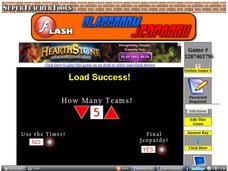National Science Teachers Association
Metals Metalloids Nonmetals
When physical science classes are becoming familiar with the periodic table of elements, you can use this set of printable cards to help them memorize some of the members of the metals, metalloids, and nonmetals groups. There are 24...
Virginia Department of Education
Metals, Nonmetals, and Metalloids
How can one easily classify metals, nonmetals, and metalloids? Pupils answer this question as they experiment with unknown substances and perform tests on conductivity, brittleness, and malleability to determine which unknown belongs in...
Curated OER
Metals, Non-metals, Metalloids
Students discuss the physical and chemical properties of metals and non-metals. As a group, they classify items as a metal or non-metal. Using the periodic table chart, students discuss the characteristics of each metal. Based upon...
Science Geek
Element Classes
Introduce your young chemists to alkali metals, alkali earth metals, transition metals, metalloids, nonmetals, halogens, and noble gasses with a presentation that explains the classes of elements and a few facts about each.
Chemistry Teacher
Metals, Nonmetals, and Metalloids Lab
What an exciting way to introduce your blossoming chemists to the world of metals, nonmetals, metalloids, and polymers! Here is a lab activity that is designed to allow pupils the opportunity to visualize the reaction of metals,...
Curated OER
Pursuit of The Properties of Metals and Nonmetals
Students examine how every element is classified based on the physical and chemical properties. For this properties of metals lesson students divide into groups, complete a lab and finish a data sheet.
Curated OER
Metalloids
Students discuss metalloids, their use as semiconductors, and their impact on the computer industry. They work in groups to create a visual timeline showing the evolution of the computer.
Curated OER
Metals, Nonmetals, Metalloids
Young scholars recognize that metals, nonmetals, and metalloids have common attributes. They Identify physical and chemical properties. Students define ores and identify where ores can be found.
Curated OER
The Periodic Table
The slides are nicely designed in this presentation about metals, metallic bonding and the difference between the properties of the main groups of elements found on the Periodic Table. This presentation focuses on the metal, and...
Curated OER
The Periodic Table
In this periodic table learning exercise, students complete a paragraph containing facts about the periodic table by filling in 18 terms from a word list.
Curated OER
Amazing Carbon
Explore carbon and bonding with this worksheet. First, class members read a short excerpt about carbon and its characteristics. In response to the reading, they draw an electron dot diagram of carbon as well as diagrams of compounds...
Curated OER
The Periodic Table
Eighth graders read and interpret the Periodic Table. They also make decisions on how to group and arrange different kinds of matter and draw the structure of atoms of pure elements. Finally, 8th graders contrast and compare basic...
Curated OER
Unit 4 - Periodic Table
There are 17 multiple choice questions on this periodic table test. The focus is on properties of the elements by group and period. The exam is not formatted well, making it a little difficult to read. There is also a typographical...
Curated OER
Organization of the Elements and Periodic Table
Students identify how to relate the position of an element in the periodic table to its atomic number and atomic mass. They also identify and interpret how to use the periodic table to identify metals, semimetals, nonmetals, and...
Curated OER
Periodic Table Assignment
In this periodic table worksheet, students complete a crossword puzzle given 22 clues about elements in the periodic table, periodic law, properties of elements and atomic mass and number. Students also fill in a periodic table to...
Curated OER
Periodic Table Lesson Plan
Students describe how elements are arranged on the periodic table. They compare metals, nonmetals, and metalloids based on their properties and on their locations in the periodic table. Students describe the differences between a...
Curated OER
Arranging the Elements
Students describe how elements are arranged in the periodic table. They compare metals, nonmetals, and metalloids based on their properties and on their location in the periodic table. Finally, students identify and describe the...
Curated OER
Elements, Compounds, and Mixtures
In this elements, compounds, and mixtures worksheet, students answer questions about the properties of elements, mixtures, and compounds. Students identify the physical changes that is made to a substance to determine if it is an element.
Super Teacher Tools
Classroom Jeopardy
Why not review for that chemistry test with a little healthy classroom competition? With a fun and interactive Jeopardy-style game, you can adjust the number of teams, keep track of scores, and even make your own test if the provided...
Curated OER
Building Blocks of Matter
In this science worksheet, students identify different parts of one element from the periodic table. Students also complete a chart by writing the appropriate characteristics for metals, metalloids, and nonmetals.
Curated OER
Elements
In this elements worksheet, students write in the symbol of the chemical element that matches its description. This worksheet has 10 fill in the blank questions.
Curated OER
Color Coding the Periodic Table
In this periodic table instructional activity, students color code the periodic table to show groups of elements, the states of elements, if they are man-made or synthetic elements, if they are radioactive and the number of electrons in...
Curated OER
Minerals and Rock Cycle Review
In this minerals and rocks worksheet, learners answer questions about the chemistry of minerals, scratch tests, rocks and the rock cycle, and erosion and deposition.
Curated OER
Introduction to the Periodic Table
In this periodic table worksheet, students will label the atomic number, atomic mass, element name, and element symbol for oxygen. Then students will determine the characteristics of the different groups of elements on the periodic table...

























